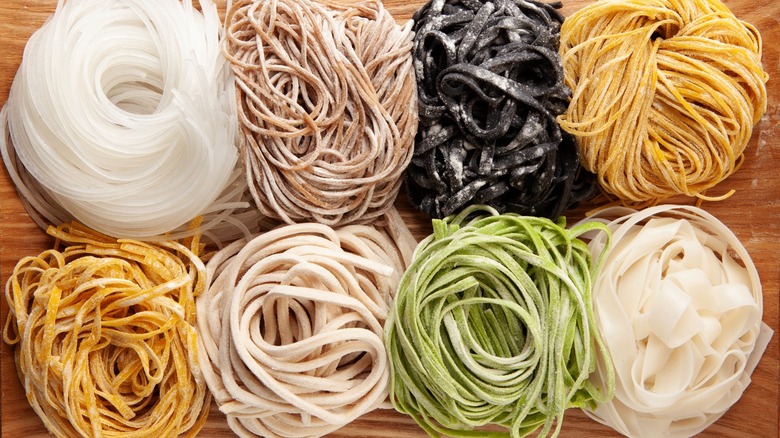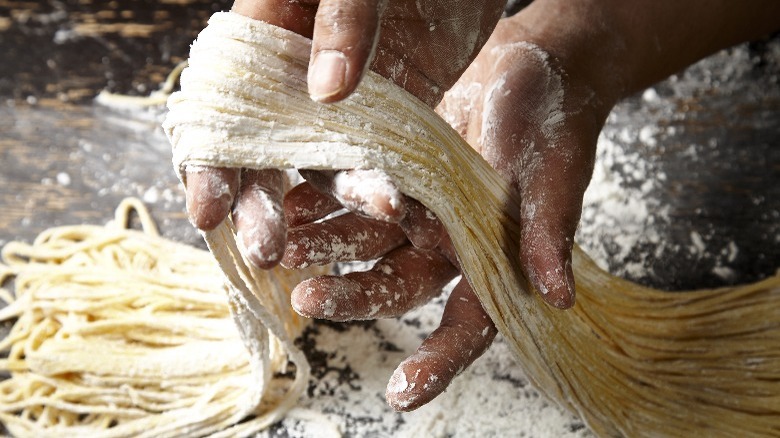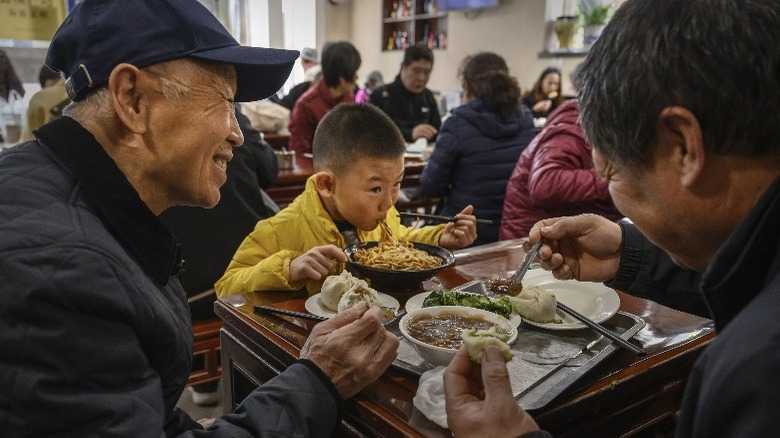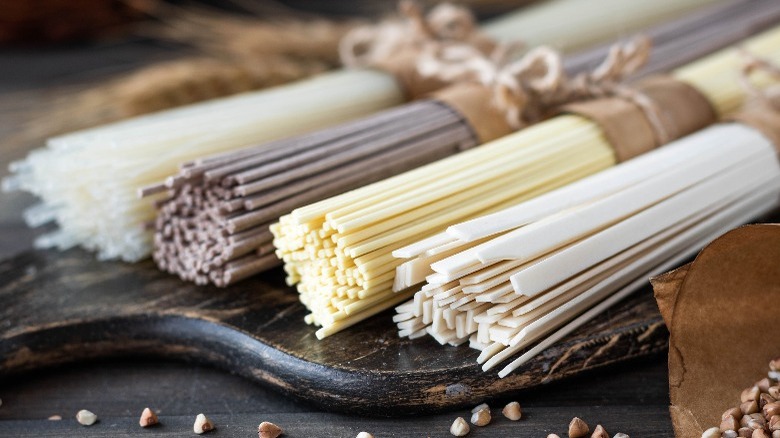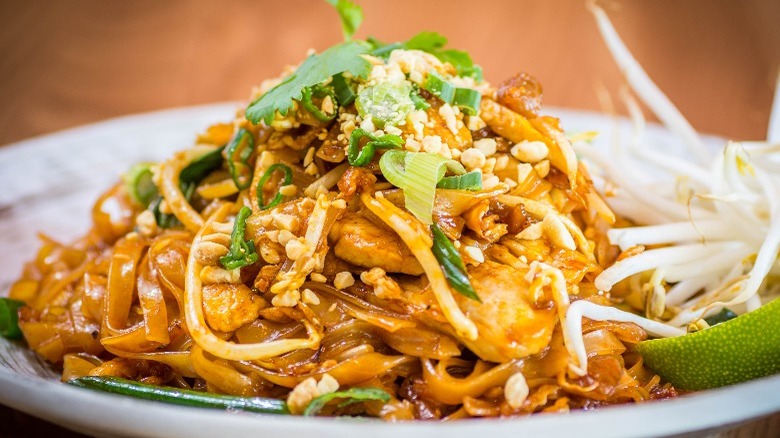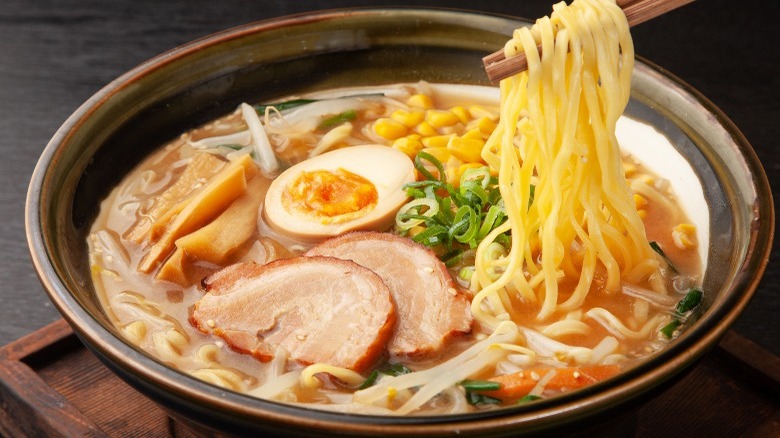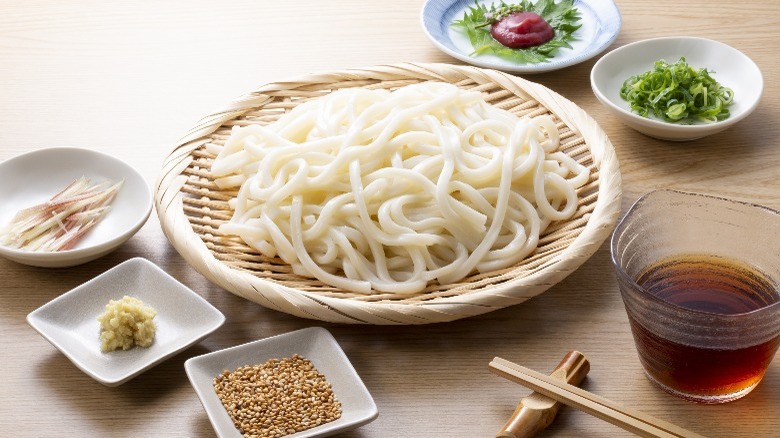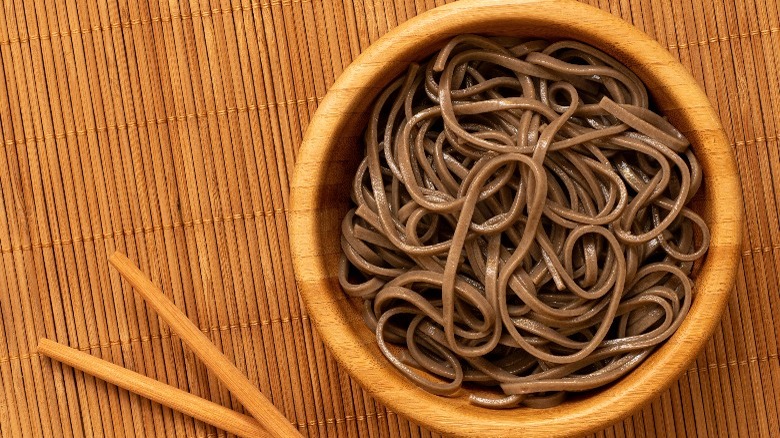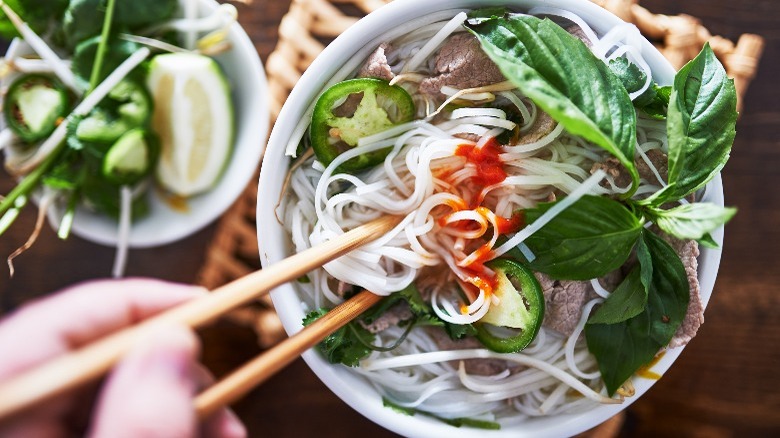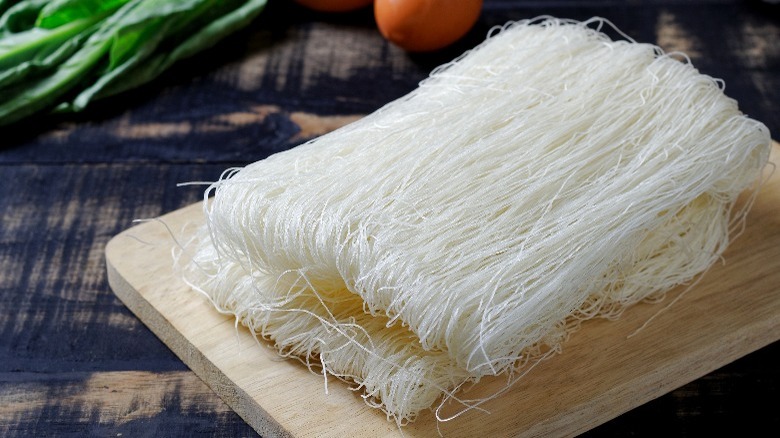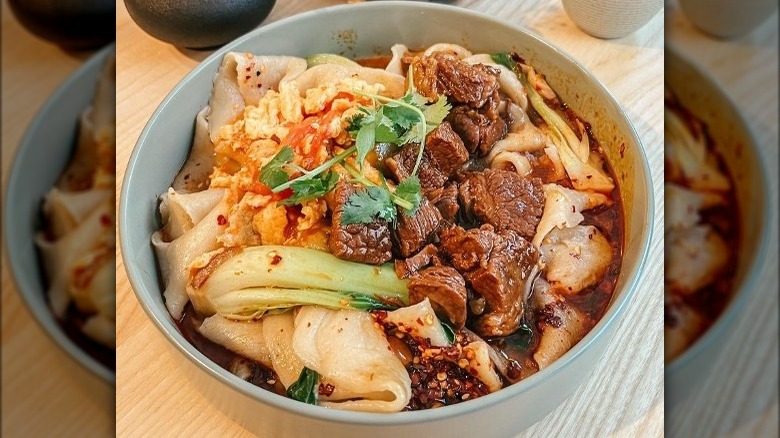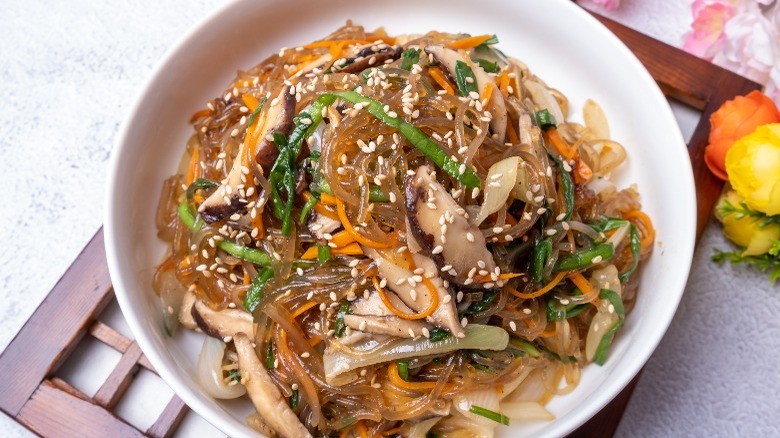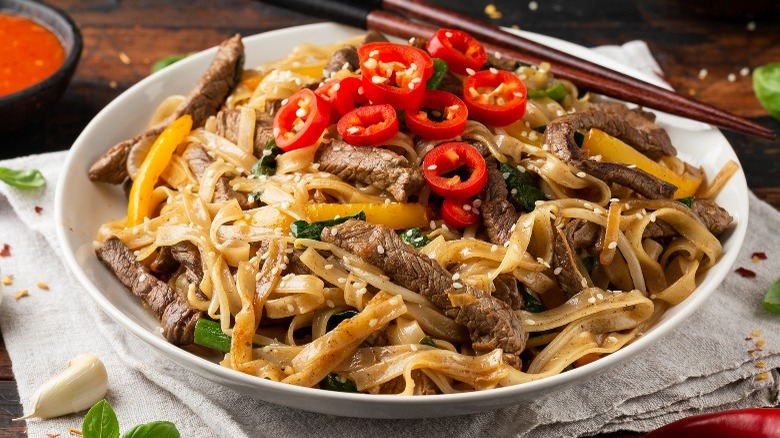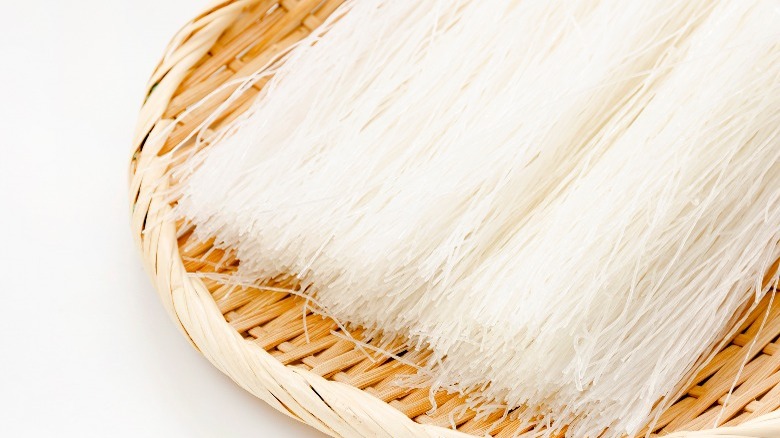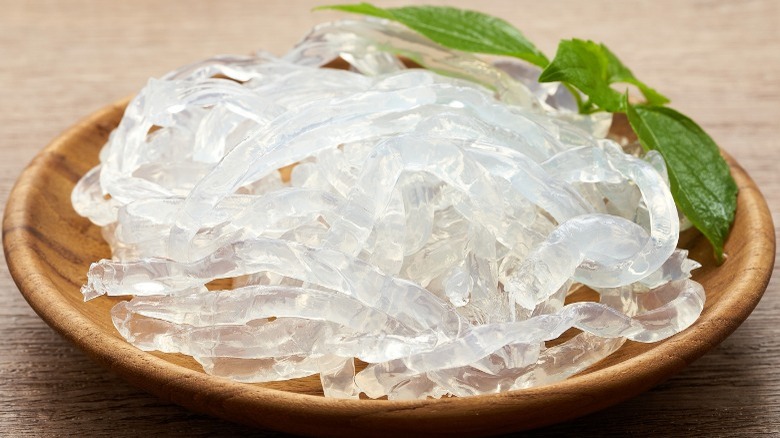The Ultimate Guide To Asian Noodles
If there's one food that's ubiquitous across Asia, it's the noodle. Throughout the continent, noodles are considered a key ingredient in Asian cuisine. They're used to make delicious dishes like pad Thai, pho, and chow mein.
Although the origins of noodles are murky — some say they originated in the Middle East, others claim they were created in China — it's safe to say they've been around in China for at least 4,000 years. We know this as archaeologists discovered an ancient bowl of noodles in the early 2000s in northern China. When overturned, the bowl contained strands of noodles made from millet.
Today noodles are eaten worldwide and hold cultural significance in many different countries. They're traditionally eaten on birthdays and on the Lunar New Year in China, where they're a symbol of good health and longevity. When you think of noodles, you likely think of the classic egg variety found in many Chinese dishes, but noodles can be made from various ingredients, including rice flour, buckwheat flour, bean or sweet potato starch, and even seaweed. In this guide, we'll look at the most popular types of noodles, where they're consumed, and what you can make with them.
What are noodles made from?
Most of us have eaten classic egg noodles in a stir fry or chow mein, but did you know that noodles can be made from a wide range of other ingredients? Flour is a key ingredient in many noodles, and the flour used can be sourced from wheat, rice, or even buckwheat.
Noodles can also be made from root vegetable starches such as sweet potato starch in dangmyeon noodles, mung bean starch, or even kelp noodles. There are variations in the styles of noodles you'll find too. Some are long and flat, requiring a quick soak in warm water to soften them, while others are round and chewy, designed to be added to hot soup and cooked through. Others are thin, delicate, and translucent, ideal for serving in warm or cold summer salads.
Some of the most popular noodles in restaurants across Japan and China are hand-pulled noodles made with care by skilled chefs and are then air-dried. However, you'll find most pre-packaged noodles on grocery store shelves are machine-made. Still, you could even try making your own noodles at home.
Which countries consume the most noodles?
China and Hong Kong sit at the top of the list when it comes to countries that consume the most noodles, with Indonesia and Vietnam taking second and third place, respectively. It may surprise you that the U.S. is in sixth place, not far behind Japan, which takes fifth place.
Bear in mind that the types of noodles consumed in each country will also vary. For example, in Thailand and Vietnam, flat rice stick noodles are commonly used and found in dishes such as pad Thai and pho. In Japan, you're more likely to find people eating steaming bowls of ramen noodles or thick, chewy udon noodles, or nutty brown soba noodles.
In the U.S., you'll often hear various types of pasta, such as spaghetti, referred to as noodles. While that's common in the U.S., in most other parts of the world, the word noodles refer to those used in Asian dishes rather than traditional Italian pasta like spaghetti or lasagna.
What are some of the most popular types of noodles?
Before we take a more detailed dive into some of the world's best-loved noodles in detail, let's take a quick look at some of the most popular types of noodles consumed across Asia. We'll start with ramen, the Japanese wheat noodle commonly used in the noodle soup of the same name. As well as finding ramen in noodle soup, it's also the type of noodle you'll find pre-packaged with a sachet of flavoring in instant ramen.
Next, we have rice stick noodles. You'll probably know them from pad Thai, the sweet, spicy, salty, sour noodle dish served across Thailand — they are also the signature noodle used in Vietnamese pho. Back to Japan, where udon and soba noodles are two of the other most common noodles you'll come across. Udon is made from wheat flour and is characterized by its thick, pale appearance and chewy texture. In contrast, buckwheat flour noodles, known as soba, are thin, light brown, and often served in salads.
Which dishes are noodles used in?
There are so many dishes you can make with noodles that we couldn't possibly list them all here, but there are those that are popular across Western countries, such as the U.S. and U.K. First up, pad Thai tops our list of delicious dishes you can make with noodles. A simple sauce made with shallots, garlic, tamarind, fish sauce, and palm sugar is mixed with flat rice stick noodles and an array of other fresh ingredients.
Next on the list is vegetable chow mein, the popular Chinese dish made with vegetables — meat eaters can also add in chicken, beef, or pork — that is stir-fried with noodles and an oyster and soy sauce-based sauce. Then, there's Ramen — another popular dish consumed in Japan but eaten widely in many Western countries. Ramen is essentially a steaming hot and delicious bowl of noodles, broth, meat, and toppings.
Lastly, we have Vietnamese pho. This popular Vietnamese soup uses a beef stock base with aromatic spices such as cinnamon, star anise, cloves, coriander seeds, and fennel seeds. All in all, noodles don't need to be relegated to hot soups and stir-fries. There are plenty of delicious noodle salad recipes out there to enjoy during warmer weather, and you can even use vermicelli noodles in summer rolls with chicken, beef, vegetables, or shrimp.
Ramen
When you hear people speaking about ramen, they're generally talking about the Japanese noodle dish, but the noodles that go into this popular meal take the same name. Ramen noodles are made from wheat flour, water, and salt. The dried variety found in instant noodle packets bears some resemblance to the fresh noodles, which are yellow, thin, and very long.
The fresh version of ramen noodles has a unique chewy texture and flavor thanks to the added alkalizing agent. Traditionally, mineral-rich water known as kansui was used, though today, it's more commonly lye water. By far, the most popular dish to use these noodles in is, well, a bowl of ramen soup. Though ramen is a popular Japanese dish, it has its roots in China in the early 1800s. It's thought to have traveled to Japan with immigrants around 1868.
Hearty and comforting, you'll find various different regional variations of ramen, but the five most common broths used are miso ramen made with fermented soybean paste, shoyu ramen made with soy sauce, tonkotsu ramen made by boiling pork bones, shio ramen made with chicken bones, and tsukemen ramen where the noodles are served alongside the broth.
Udon
Udon noodles are thick and chewy and are made with flour, salt, and water. Each region of Japan has its own special style of udon, with the hardness and thickness varying depending on where in the country you are.
These noodles were thought to have come to Japan from China, and today they're commonly served hot in soup dishes such as kake udon, with a dashi-based broth. They can also be added to stir-fries such as the popular yaki udon or used cold in salads during the summer months. Their neutral flavor makes them a great match for spicy or salty dishes or other strong flavors.
These noodles are generally found pre-cooked and sold in vacuum packs. To refresh, soak them for a few minutes in boiling water, untangling them gently with a fork or chopsticks before draining and using them. You'll also find dried udon noodles that will need to be soaked for around seven minutes before adding them to your dish.
Soba
Soba noodles take their name from the Japanese word for buckwheat. Packed with vitamin B, these gluten-free noodles are traditionally made with buckwheat flour and water. Some varieties are made with a blend of wheat flour and buckwheat flour, though.
These noodles are said to have their roots in China, arriving in Japan sometime between 10,000 B.C. and 300 B.C. Their light brown, thin appearance and nutty flavor ensure they're delicious served cold in summer noodle salads, often with a spicy peanut and sesame dressing. They can also be served hot in broth or as plain drained noodles with sauce on the side to dip.
You'll generally find packs of dried buckwheat noodles in larger grocery stores or specialist stores. They're a great alternative to wheat noodles for anybody watching their blood sugar levels, as they are a lower glucose index food than some other types of noodles, according to Healthline.
Rice Stick
Rice stick noodles are dried rice noodles that come in several different widths. More elastic than other types of noodles, they're great in stir-fries as they won't break apart. These noodles date back to ancient times, first making an appearance during the Qin dynasty in 259-210 B.C.
You'll most commonly find rice stick noodles used in pad Thai alongside a tangy, sweet, salty, and spicy sauce made with shallots, garlic, palm sugar, fish sauce, and tamarind. Traditional pad Thai uses a combination of pressed tofu, dried shrimp, sweet pressed radish, chili, eggs, roasted peanuts, bean sprouts, lime, and garlic chives. Western versions often omit some of these ingredients or add fresh shrimp or chicken to the dish.
Rice stick noodles are also key to Vietnam's national dish, pho, an aromatic soup made with beef bone broth, spices, and herbs. To prepare these noodles, just soak them in hot water briefly to soften before adding them to your stir-fry or soup.
Rice Vermicelli
Not to be confused with rice stick noodles, rice vermicelli are also known as bahn hoi in Vietnam, mie fen in China, or sen mee in Thailand. Rice vermicelli is made with rice or rice flour and water, and these noodles look a lot like cellophane or glass noodles, with a similar texture and neutral flavor.
Rice vermicelli is usually sold dried and should be soaked in water for six to seven minutes before boiling for around a minute. The fine texture of rice vermicelli makes these noodles an excellent addition to summer rolls, where chicken, shrimp, and/or vegetables are added to the noodles in a soft rice paper wrapper, served with a spicy dipping sauce.
They can also be used in salads or soups or served with grilled meats. In Vietnam, rice vermicelli is a key component of bun cha, chopped grilled spicy pork with raw vegetables, and a hot, sour, sweet, and salty sauce of fish sauce, sugar, vinegar, garlic, and chili.
La mien
La mien noodles are often referred to as "pulled" noodles. Made with wheat flour and water, they're generally found fresh and are handmade by skilled chefs. You'll find these noodles come in a variety of thicknesses, depending on where you get them in China.
These tasty noodles are commonly served in Northern China, and they have a toothsome texture thanks to the alkalizing nature of the added lye water or bicarbonate of soda. This chewy finish makes them an excellent addition to soups, hotpots, and even stir-fries.
Appearance-wise, these noodles look thicker than most other noodles you'll find, more like tagliatelle or pasta, than the thinner noodles we're used to seeing. You could try making your own la mien noodles at home, but skilled noodle chefs have years of experience perfecting their craft, so it might be best to save these for the next time you eat out.
Dangmyeon
Dangmyeon noodles look a lot like harusame noodles, but they're a darker tan color with a thicker, springy texture. Made from sweet potato starch, these noodles are widely used in Korean cuisine.
The popular Korean dish Japchae – literally mixed vegetables — is made with dangmyeon noodles, and you can use any vegetables you have to hand, though it's important to shred them into thin strips. The dish traditionally uses beef with a simple soy sauce, sugar, and sesame oil sauce.
Dangmyeon can also be added to soups and stews, and they're a key component of the Korean street food kimmari or gimmari, where they're wrapped in dried seaweed and fried. They're also popular in Andong jjimdak, a dish made with chicken braised in soy sauce.
To prepare dangmyeon, soak them in warm water for a few minutes, then rinse them in cold water before adding them to your japchae or other noodle dishes. You'll also find a Chinese version of these noodles, but they're slightly thicker.
Chow fun
Chow fun noodles, also known as he fen, are found in Cantonese cuisine. These flat, wide noodles are a similar width to the rice stick noodles used in pad Thai, though they're a darker yellow color. There's no pre-cooking required with these noodles, as they're usually sold fresh. To separate them before cooking, a quick rinse in boiling water is all that's needed.
Use these noodles to whip up delicious Cantonese beef chow fun or gon chow ngau huo with beef strips, bean sprouts, ginger, scallions, and a sauce made from dark and light soy sauce, Shaoxing wine, sugar, and sesame oil. Chow fun noodles are also commonly found in the Malaysian and Singaporean dish char kway teow. This popular spicy street food dish is made with noodles, prawns, and Chinese sausage.
You could also try making your own chow fun noodles with rice flour, tapioca or cornstarch, salt, water, and oil. While making the noodles isn't that complicated, handling the dough and cutting them into the right shapes can be tricky.
Harusame
Don't confuse harusame noodles with dangmyeon noodles found in Korean cuisine, usually made from sweet potato starch. These noodles are originally made from mung bean starch. These noodles are slightly thicker than bean thread vermicelli. You'll often hear them referred to as glass noodles, cellophane noodles, or salad noodles.
Preparing these noodles involves a soak in hot water for around five minutes, after which they can be drained and added to a variety of dishes. They're most commonly used in Thai and Japanese salads and cold dishes served with spicy dressings but can also be found in the minced pork Sichuan dish called ants climbing the tree.
Harusame noodles absorb less broth than some other noodles, so they're also an excellent addition to hot pots or noodle soups. They can even be added to Vietnamese summer rolls, although traditionally, rice vermicelli noodles are used.
Other noodles
With so many varieties of noodles out there in the world, there is definitely a lot more to cover. Noodles can be made from many different ingredients, like seaweed, so there are a few other, less common, types of noodles worth mentioning.
For starters, kelp noodles are similar in appearance to glass noodles, and they're usually sold ready to eat. As their name suggests, they're made with kelp, also known as seaweed, free from fat or carbohydrates and rich in iodine. You can use them as you'd use glass noodles, in summer rolls, fresh noodle salads, or even in stir-fries. Another type of noodle is dotori guksu — this soba-like noodle is made from a blend of flours, including acorn flour and buckwheat. It's popular in Korea, where its sweet nuttiness adds flavor to stir-fries and salads.
You may also come across you mian or oil noodles. These are purchased fresh, and you'll usually find them in the chilled section of your local Asian food store. You mian noodles are treated with alkaline salts, similar to ramen, giving them a chewy texture. They're commonly used in liang mian, a spicy Sichuan noodle salad, but they can also be used in soups and stir-fries.
